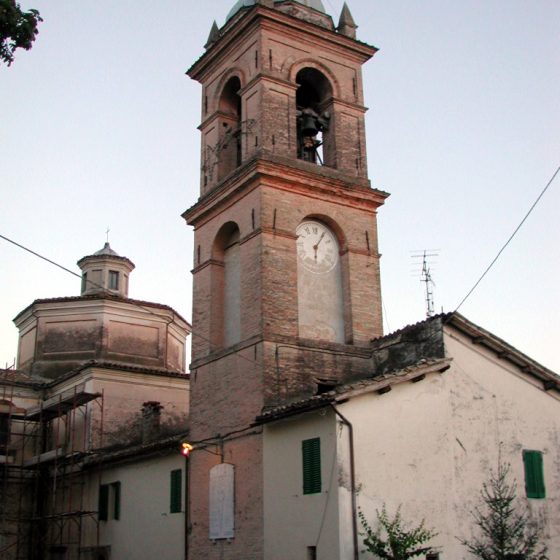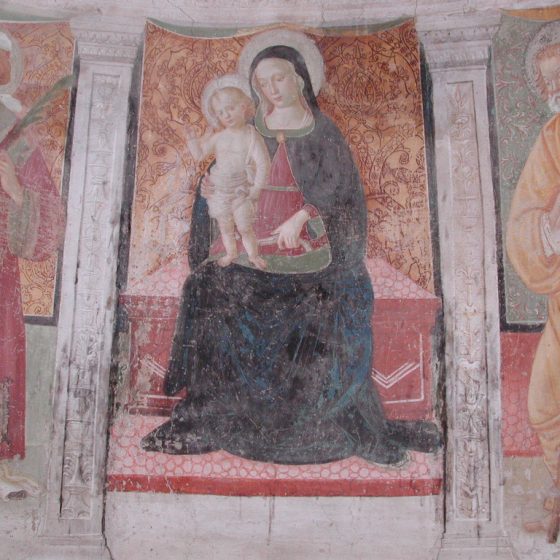La chiesa è una struttura a quattro navate, a croce greca.
Dalla cupola emerge una lanterna ottogonale con quattro finestre tabernacolari.
Fu ricostruita dalle fondamenta nel 1902 per volontà del parroco don Pietro Bolletta e consacrata dall’allora arcivescovo di Spoleto, mons. Domenico Serafini.
All’interno della chiesa si conservava una tavola cuspidata raffigurante una Madonna con bambino in trono, attribuita a Bartolomeo da Miranda, oggi al museo diocesano di Spoleto.
Le opere di maggior pregio sono presenti nell’abside, ove si riconoscono, tra le altre di minore valore frutto del lavoro di bottega, le figure della Madonna e del Santo patrono degne dei migliori lavori di Francesco Melanzio, discepolo del Perugino.
La chiesa fu realizzata prima del castello di Picciche, come testimoniato con certezza dalla presenza di un affresco datato 1510, dipinto, sulla parete sinistra, ad opera della bottega del Melanzio, forse dal nipote Febo.
Di questo lavoro ricordiamo un crocefisso tra quattro Santi, di cui oggi restano i ss. Sebastiano e Antonio Abate.
Di particolare pregio è anche l’organo, opera del Maestro Calogero La Monica di Viterbo e di suo figlio Pietro.
Tale strumento fu inaugurato il 16 ottobre 1805 nella chiesa di San Luca, a Spoleto. Fu quindi acquistato nel 1919, per 1.000 lire, dal parroco di Picciche, don Pietro Bolletta.
L’organo, a lungo inutilizzato, è oggi perfettamente funzionante grazie ai restauri della ditta folignate del signor Umberto Cruciani.
È possibile che questo edificio sia stato costruito sui ruderi di un antico tempio pagano.
Su un muro di questa chiesa lo spoletino Giuseppe Sordini, insigne archeologo, rinvenne un cippo con un’iscrizione in latino arcaico, risalente alla fine del II o III secolo a.C.
Si tratta di un blocco calcareo con incisa la così detta “lex spoletina” o “lex lucaris”:
Nessuno violi questo bosco né trasporti né porti via ciò che è bosco né tagli fuorché nel giorno in cui si farà il sacrificio annuo. In quel giorno, purché si faccia per causa del sacrificio, sia lecito tagliare senza colpa. Se qualcuno lo avrà violato, offra a Giove un sacrificio espiatorio con un bue e ci siano per quel sacrificio 300 assi di multa e l’esazione della multa spetti al consacrante.
Il tempio sui ruderi del quale, secondo un’antica tradizione, è stata forse edificata la chiesa di Picciche poteva essere dedicato a Giove e la legge incisa sulla pietra poteva essere quella di tutela di un bosco sacro qui presente. Una selva ormai scomparsa, che a quel tempo era lambita da un’importante via di comunicazione.
Precedentemente, sul colle di San Quirico era stato rinvenuto un altro cippo della stessa epoca, sempre riportante la legge di tutela del bosco sacro.
L’archeologo Sordini, che ne apprezzò l’importanza, provvide a rimuoverli dai luoghi di ritrovamento per farli custodire nel museo di Spoleto.
TREVI, PICCICHE, CHURCH OF SANTO STEFANO
The church has a Greek cross structure with four naves.
An octagonal lantern with four tabernacle windows emerges from the dome.
It was rebuilt from its foundations in 1902 at the request of the parish priest Don Pietro Bolletta and consecrated by the then archbishop of Spoleto, Msgr. Domenico Serafini.
Inside the church there was a cuspidate table depicting a Madonna with child enthroned, attributed to Bartolomeo da Miranda, now in the diocesan museum of Spoleto.
The most valuable works are present in the apse, where the figures of the Madonna and the patron saint can be recognized as Francesco Melanzio’s best works among others of lesser value. Melanzio was a disciple of Perugino.
The presence of a fresco dated 1510 is certifiable evidence that the church was built before the castle of Picciche. It was painted on the left wall by one of Melanzio’s workers, perhaps by his nephew Febo.
Of this work we remember a crucifix between four Saints, of which Saints Sebastian and Antonio Abate remain today.
The organ is valuable, the work of Maestro Calogero La Monica from Viterbo and his son Pietro.
This instrument was inaugurated on October 16, 1805 in the church of San Luca, in Spoleto. It was then purchased in 1919, for 1,000 lire, by the parish priest of Picciche, Don Pietro Bolletta.
The organ had not been used for a long time but is now fully functional thanks to the restoration by a Foligno firm owned by Mr. Umberto Cruciani.
It is possible that this building was built on the ruins of an ancient pagan temple.
On a wall of this church the Spoleto Giuseppe Sordini, a distinguished archaeologist, found a stone with an inscription in archaic Latin, dating back to the end of the second or third century BC
It is a limestone block with the so-called ‘lex spoletina’ or ‘lex lucaris’ engraved: «No one violates this wood or transports or takes away what is wood or cuts except on the day in which the annual sacrifice will be made. On that day, if it is done for the sake of sacrifice, it is permissible to cut without guilt. If someone has violated it, he offers Jupiter an atoning sacrifice with an ox and there are 300 axes of fine for that sacrifice and the collection of the fine belongs to the consecrator».
Picciche’s church was likely built on the temple ruins which, according to ancient tradition was dedicated to Jupiter and the law engraved on the stone was intended to protect a sacred wood present there; a forest which no longer exists, but at the time was adjacent to an important communication route.
Previously, on the hill of San Quirico another stone from the same period was found bearing the law protecting the sacred wood.
The archaeologist Sordini, who appreciated their importance, took steps to remove them from the places of discovery to preserve them in the museum of Spoleto.
The translation of this post is edited by Patrizia ANTONELLI


